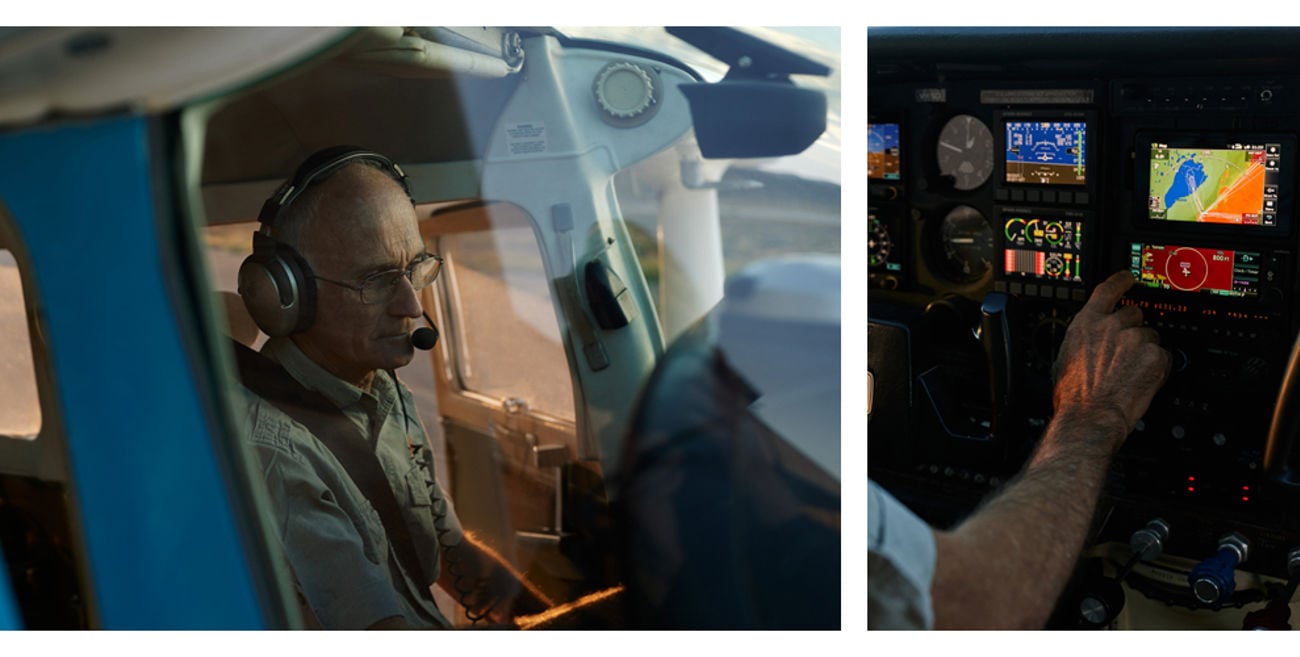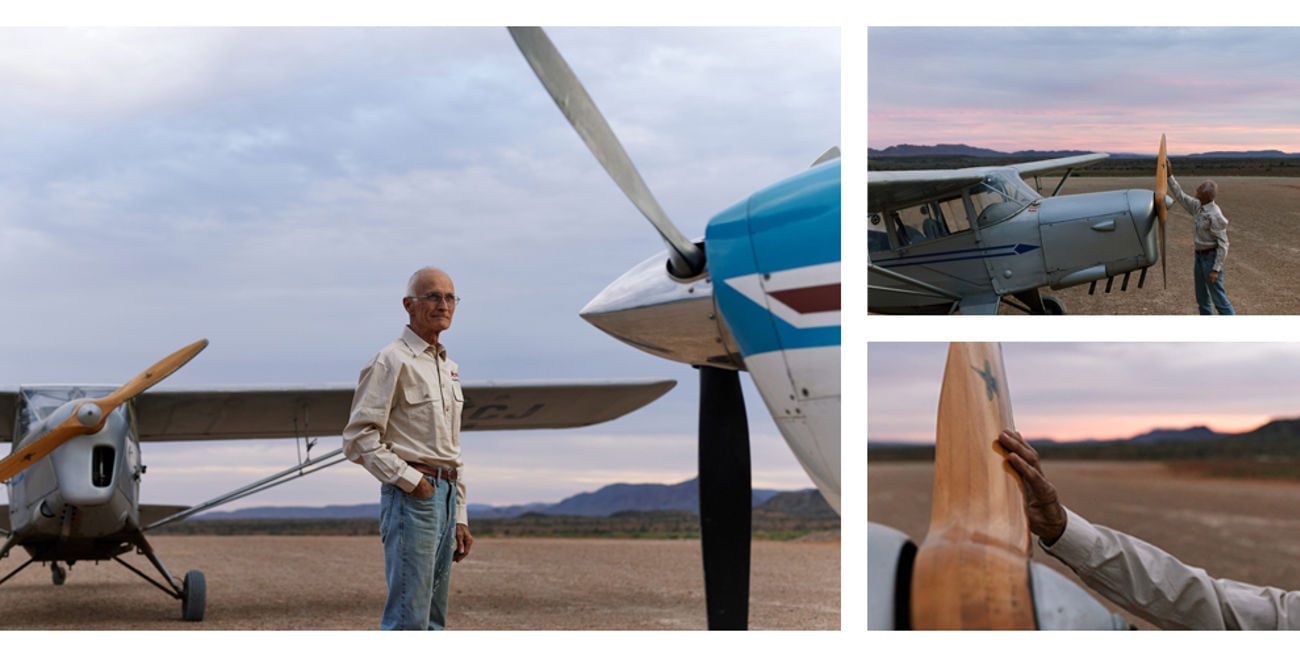STORIES OF THE SOUTH S1 EPISODE 1: OUTBACK AVIATOR
In the depths of the South Australian outback, the sky sets the stage for a high-flying crusader .
Meet Doug Sprigg, an outback pilot who spends his days flying over the wild frontiers of his backyard, the vast South Australian outback. His flight path covers 800,000 square kilometres, an area bigger than Belgium, Netherlands and France combined. The 66-year-old runs and lives at Arkaroola Wilderness Sanctuary in the farthest reaches of the Flinders Ranges and says it’s craggy peeks, towering ridgelines and sweeping gorges are best explored from the air.
A diesel mechanic and pilot by trade, and historian, geologist, and biologist in knowledge alone, for 30 years, he’s taken to the sky to share his love for Arkaroola. Out here, there’s no traffic control, flight attendants or flight service. It’s Doug, his Cessna 207, a 650-metre airstrip, and some of the most pristine and untouched country left in Australia.
In our first interview for Stories of the South, meet one of South Australia’s outback aviators, and discover the wildlands in which he lives and works.
1. What is it like flying in such a remote part of the country?
We’re in Class G airspace so it’s the dirt roads of aviation. There’s no air control as such, the pilots work together so there’s a bit more freedom. As much as I love flying, I really prefer having someone with me to share it with. In the busy season, I can be flying six days a week, sometimes four times a day, but it never grows old. I love seeing people’s reactions flying over the rangeland. We cruise at an altitude anywhere from 500 to 1000 feet up to 9,500 feet so you get a lot of different perspectives. Our most popular local flight is about 120km and we fly over the ranges, the deserts and outback lakes. A lot of these places are particularly hard to access with vehicles so flying really unlocks the outback.
2. Tell us about your corner of South Australia.
We’re about eight hours drive from Adelaide and there’s 130 kilometres of dirt road at a minimum depending on which way you come so having access to a plane is vital. Distance is a problem for us in some ways but it’s also a blessing. Even in the busy season, you can feel like it’s just you and nature. There are not many places left in the world where you can say that. These arid lands are defined by deep, crustal granites but it’s also a landscape of great contrast and you can really appreciate that from above. There are gorges, beautiful water holes, hot springs, unique plant life and abundant wildlife. This is a place for people to reconnect with nature and gain a greater appreciation of how we can coexist with all of the things that make our planet so special. It’s not our place, it’s everybody’s place. We want people to see it, enjoy it and help us preserve it.

3. How did you become to be an Outback Pilot?
One of the earliest and most vivid memories I have is sitting on my dad’s lap in his Avro Anson, a World War II aircraft he used for surveying. I’ve always loved being in the sky and would always ask to go with him on flights. Growing up, I was one of those people who was happy just sitting at the airport watching planes, but of course I wanted to fly them myself too. I’ve been a commercial pilot since 1993 and I’ve had my private licence since 1971. Now, my son is a pilot down at Wilpena Pound so the love of flying has been passed down three generations.
My other passion is astronomy, so I guess I’m drawn to the sky. One of the things I love about astronomy is how small it makes you feel. Flying can give you that same feeling, it’s like looking through a telescope. You get to know the landscape in a way you couldn’t from the ground and I’m invigorated by the fact that I’m just a tiny little bit of it.
4. Tell us about your most memorable outback experience.
The moment my love for the outback began. I was seven years old travelling with my parents across the Simpson Desert. It was the first motorised crossing of the Simpson Desert and it was just a real adventure. There was no sat-nav back then, dad navigated with aerial photos and a sextant in our Nissan Patrol. It took us 11 days to cross 1,100 sand dunes and we camped under the stars every night. The experience shaped my life and cemented my future in the outback.

5. What are the top five things travellers who want a little more should have on their Arkaroola and outback South Australia bucket list?
Outback flight: to truly appreciate the vastness of the outback, you need to take to the sky. From the air, you can put the geology together and see ranges, deserts, and lakes from above.
Arkaroola Ridgetop tour: the ridgetop tour is Arkaroola’s most iconic experience. You’ll unearth some of Arkaroola’s most inaccessible and breathtaking landscapes as you scale towering granite gorges in an open-top four-wheel drive.
Echo Camp backtrack: following the route used by Sir Douglas Mawson through the rugged northern mountains, the Echo Camp backtrack traverses some of Arkaroola’s most breathtaking landscapes. Serious four-wheel-drivers can tackle the track, or we offer half-day tours from Arkaroola.
Stargazing: Arkaroola is home to one of the largest privately owned astronomical observatories in Australia and the dry climate and high altitude means this area is uniquely positioned for stargazing. You’ll see the Milky Way, distant galaxies, planets, stars, nebulae and more in stunning clarity.
Iconic pubs: the outback experience isn’t complete without visiting a local watering hole or two. The Maree Hotel, Innamincka Hotel, William Creek Hotel and the Oodnadatta Pink Roadhouse are quintessential Australian experiences and it’s these places where you get to meet the locals who love the area and get hints on what to see that you won’t find on a tourist map.

6. When is the best time to visit Arkaroola?
Conditions are ideal for exploring anytime of the year apart from the depths of summer. The changing seasons all offer something unique. Autumn, winter and spring are particularly good if you want to go hiking. The nights can get a little cold, but the days are mild and beautiful. Native wildflowers transform the landscape in spring with pops of red from Sturt Desert Peas and yellow acacia. Wildlife encounters are normally reliable year-round, just head out early in the morning and later in the day. For astronomy, plan your trip around the darker nights for the clearest viewing conditions. From three or four nights after a full moon through about two weeks to the first quarter moon is the best time for stargazing.

7. Leave us with your favourite outback story.
I think the land tells the most intriguing story, and I try to share this with all our guests. The Flinders Ranges has this fantastic timeline through it spanning back more than 900 million years when we were part of the supercontinent Rodinia, which broke up about where we are. On this side of us you had Canada and North America just a few kilometres so you could walk across the flat to Canada and America. This area saw an ice age 700-750 million years ago, global warming immediately afterwards and then the beginning of a reef life. There’s evidence the reef was up to 1km thick, which is the thickest reef on earth, and at the time of discovery it was the oldest reef on earth.
The ridgetop area is the deep crustal granites that was molten rock 12 to 14 kilometres underground that’s been uplifted to the surface. Even today, we have a fault line that moves up to 300 times a year through Arkaroola so the ranges are still uplifting. Because the terrain is so rugged, there are pockets of isolated wilderness dotted throughout Arkaroola which act as time capsules. You can find remnant vegetation from the Pleistocene era which finished about 15,000 years ago. There are archaea, an ancient lifeform that still lives today in the hot springs of Arkaroola and pushes the edge of what we know scientifically. Just two years ago a scientist discovered three new frog species in two days, and just before that they discovered five new plant species for South Australia.
LOOKING FOR MORE?
Watch our short film about South Australia’s Outback Aviators and then start planning your trip to the outback along the Explorer’s Way with our ultimate road trip guide.

